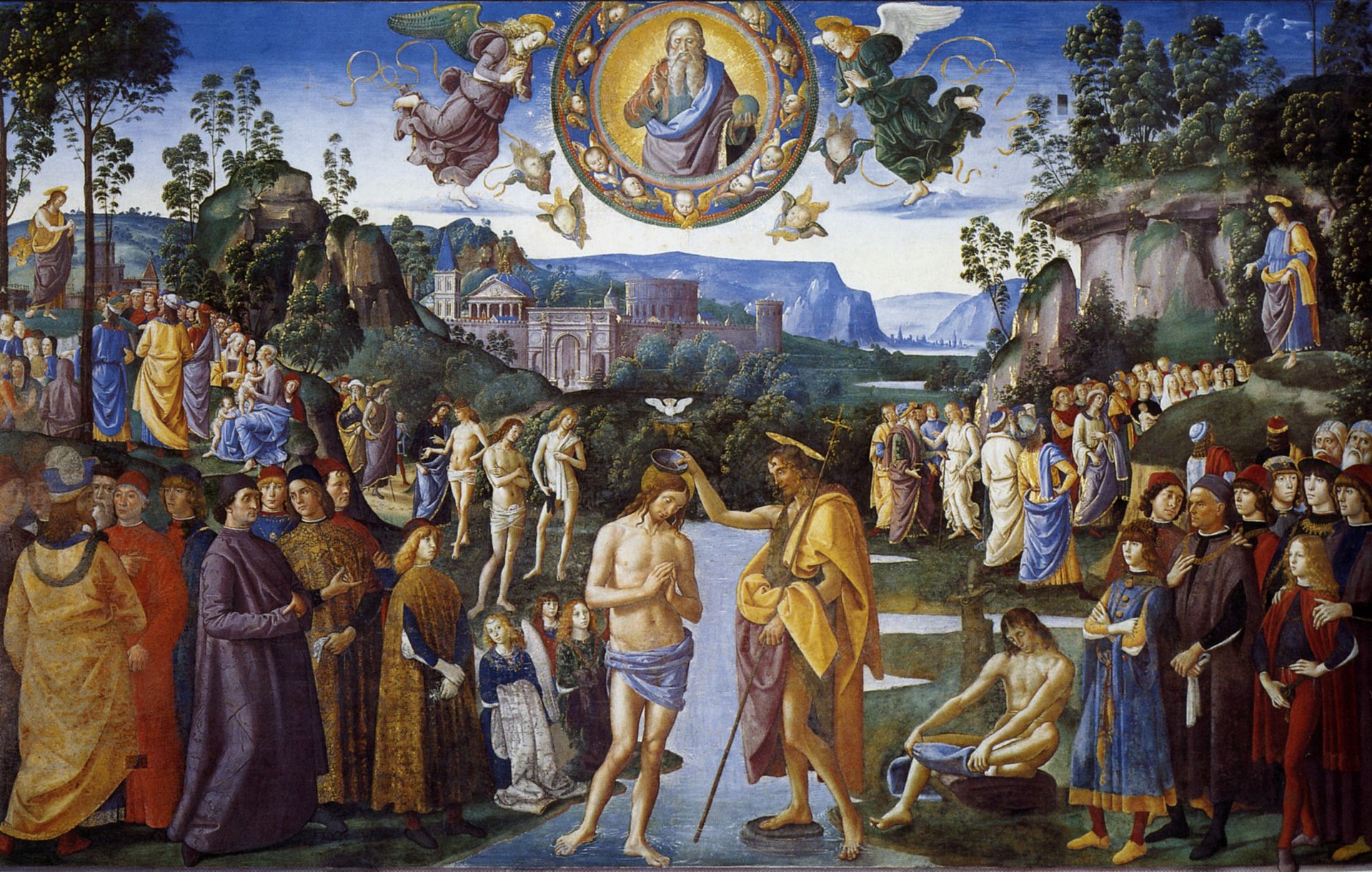[Greek] εἶδος (eidos), [Latin] apparentia, [Latin] figura, [French] idee: form, appearance, shape; Lk.3:22, Lk.9:29, Jn.5:27, 2Cor.5:7, 1Thess.5:22

The Baptism of Christ: painting by Pietro Perungino (1482)
Background information:
Greek Hellenism: This term means what is visible, model, idea, essence, appearance, form, and nature. The more nuanced meanings include state of things, beauty, plan of action, and groceries. Homer’s Iliad 3.39 states “Evil, Paris, most fair to look upon, thou that art mad after women.” Plutarch’s Themistocles 29 states “The speech of man was like embroidered tapestries, since like them this too had to be extended in order to display its patterns, but when it was rolled up, it concealed and distorted them. Plato’s Phaedo 103e states “In some such cases, that not only the abstract idea itself, has a right to the same name through all time, but whenever it exists has the form of the idea.
Old Testament: This term, related to several Hebrew terms, means sight, appearance, form, law, judgment, substance, shape, figure, family, and beauty. The Egyptians saw that the woman was very beautiful (Gen.12:14). In the evening it was like the appearance of fire over the tabernacle (Num.9:15). You shall be driven mad by the sight of what you see (Deu.28:34). These are the families of the sons of Noah (Gen.10:32). Now these are the ordinances which you are to set before them (Exo.21:1). Now Joseph was handsome in form and appearance (Gen.39:6). But My face you cannot see, for no man sees Me and still lives (Exo.33:20).
New Testament: This term means form, appearance, sight, and kind. Jesus requests that John the Baptist baptize Him. As a result, the Holy Spirit, in the form of a dove, comes down upon Him. The Father’s voice from Heaven says “You are My Son whom I am well pleased.” At the Transfiguration of Jesus, His face changed in appearance and His clothes became dazzling white. Jesus states you have never heard the Father’s voice nor seen His form. We walk by faith, not by sight. We are reminded to refrain from every kind (manner) of evil.
Scripture:
“And the Holy Spirit descended upon Him in bodily form like a dove. And a voice came from heaven, ‘You are My beloved Son; with You I am well pleased.’” Lk.3:22
The Holy Spirits appears in the form of a dove. The Father’s statement makes reference to the angel’s reference to the Son of the Most High in Lk.3:22). This is related to Psa.2:7 (You are My Son, today I have begotten you).
“Moreover, the Father who sent me has testified on My behalf. But you have never heard His voice nor seen His form.” Jn.5:37
Aside from John’s baptism, we have never heard the Father’s voice. Man would face death in the event of seeing God.
“For we walk by faith, not by sight.” 2Cor.5:7
We are all like citizens in exile, who must have courage.
Conclusion:
Idea, appearance, figure
In the Greek Hellenistic era, it is perhaps not surprising about the many meanings of this term. The more nuanced meanings include beauty, similies, metaphors, and abstractions. Plato’s essence of thing means that the idea of a thing is as real as the thing. For example, one’s idea of “chairness” is more real than any manufactured chair. This inspired Nike’s marketing slogan “Just do it”.
In the Old Testament, man is incapable of seeing God. This would cause death. Psa. 2:7 introduces God’s Son of the Most High. This later relates to the Jesus’ baptism.
In the New Testament, the Father’s voice is heard during Jesus’ baptism. Otherwise, the Father’s voice is never heard nor is seen. The angel, in speaking with Mary, makes mention of the Son of the Most High. Jesus’ face is changed at the Transfiguration. In a sense, we all walk by faith as pilgrims on a journey. The Greek paroikos means sojourner or stranger.
Good travels, fellow pilgrims. ( I think you get the idea).
